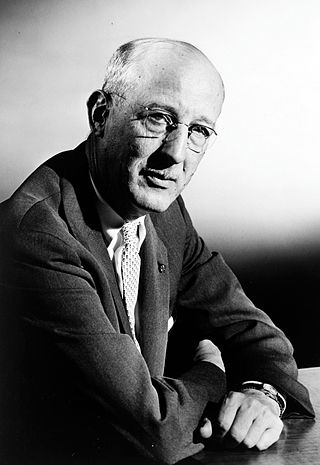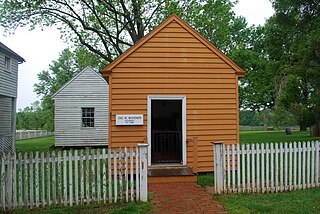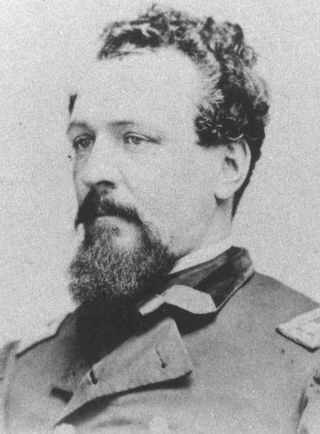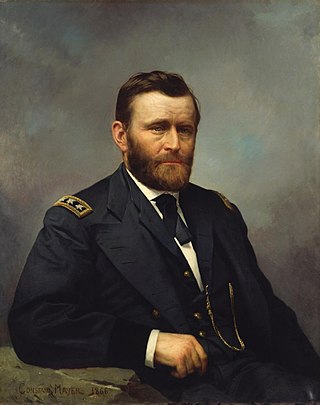
The Battle of Cold Harbor was fought during the American Civil War near Mechanicsville, Virginia, from May 31 to June 12, 1864, with the most significant fighting occurring on June 3. It was one of the final battles of Union Lt. Gen. Ulysses S. Grant's Overland Campaign, and is remembered as one of American history's most lopsided battles. Thousands of Union soldiers were killed or wounded in the frontal assault of June 3 against the fortified positions of Confederate Gen. Robert E. Lee's army, an event that compounded the image of Grant's apparent disregard for high casualties.

The Battle of the Crater took place during the American Civil War, part of the Siege of Petersburg. It occurred on Saturday, July 30, 1864, between the Confederate Army of Northern Virginia, commanded by General Robert E. Lee, and the Union Army of the Potomac, commanded by Major General George G. Meade.

The Army of the Potomac was the primary field army of the Union army in the Eastern Theater of the American Civil War. It was created in July 1861 shortly after the First Battle of Bull Run and was disbanded in June 1865 following the surrender of the Confederate Army of Northern Virginia in April.

Charles Bruce Catton was an American historian and journalist, known best for his books concerning the American Civil War. Known as a narrative historian, Catton specialized in popular history, featuring interesting characters and historical vignettes, in addition to the basic facts, dates, and analyses. His books were researched well and included footnotes. He won the Pulitzer Prize for History and the National Book Award for Nonfiction in 1954 for his book A Stillness at Appomattox (1953), a study of the final campaign of the war in Virginia and third book in his Army of the Potomac trilogy.
The Battle of Lewis's Farm was fought on March 29, 1865, in Dinwiddie County, Virginia near the end of the American Civil War. In climactic battles at the end of the Richmond–Petersburg Campaign, usually referred to as the Siege of Petersburg, starting with Lewis's Farm, the Union Army commanded by Lieutenant General Ulysses S. Grant dislodged the Confederate Army of Northern Virginia commanded by General Robert E. Lee from defensive lines at Petersburg, Virginia and the Confederate capital of Richmond, Virginia. Many historians and the United States National Park Service consider the Battle of Lewis's Farm to be the opening battle of the Appomattox Campaign, which resulted in the surrender of Lee's army on April 9, 1865.

The Battle of Appomattox Court House, fought in Appomattox County, Virginia, on the morning of April 9, 1865, was one of the last, and ultimately one of the most consequential, battles of the American Civil War (1861–1865). It was the final engagement of Confederate General in Chief Robert E. Lee and his Army of Northern Virginia before they surrendered to the Union Army of the Potomac under the Commanding General of the United States Army, Ulysses S. Grant.

Romeyn Beck Ayres was a Union Army general in the American Civil War.

The Civil War: A Narrative (1958–1974) is a three volume, 2,968-page, 1.2 million-word history of the American Civil War by Shelby Foote. Although previously known as a novelist, Foote is most famous for this non-fictional narrative history. While it touches on political and social themes, the main thrust of the work is military history. The individual volumes include Fort Sumter to Perryville (1958), Fredericksburg to Meridian (1963), and Red River to Appomattox (1974).

The eastern theater of the American Civil War consisted of the major military and naval operations in the states of Virginia, West Virginia, Maryland, and Pennsylvania, the national capital in Washington, D.C., and the coastal fortifications and seaports of North Carolina. The interior of the Carolinas were considered part of the western theater, and other coastal areas along the Atlantic Ocean were part of the lower seaboard theater.

The 20th Massachusetts Volunteer Infantry, also known as the "Harvard Regiment", was a regiment of infantry in the American Civil War. The regiment was so nicknamed because the officers of the 20th were young Harvard graduates. In addition, some, but not all, of the private soldiers had attended Harvard. The 20th was organized at Camp Meigs in Readville, August 29 to September 4, 1861. After training they left Massachusetts for Washington, D. C., September 4. They would fight until the war's conclusion being mustered out on July 16 and discharged July 28, 1865. Fogel et al's Union Army Data urban sample suggests perhaps as many as two-thirds of the regiment's enlisted were immigrants with Irish immigrants making up half of the regiment's total.

Lorinda Anna Blair Etheridge was a Union nurse and vivandière who served during the American Civil War. She was one of only two women to receive the Kearny Cross. She was inducted into the Michigan Women's Hall of Fame in 2010.
The 6th Ohio Cavalry Regiment was a cavalry regiment of the Union Army, which was raised in ten counties in northeastern and north-central Ohio for service during the American Civil War. It served primarily in the Eastern Theater in several major campaigns of the Army of the Potomac and was particularly active during the Gettysburg Campaign of 1863.

The McLean House near Appomattox, Virginia is within the Appomattox Court House National Historical Park. The house was owned by Wilmer McLean and his wife Virginia near the end of the American Civil War. Hosted by Union General Ulysses S. Grant, the house served as the location of the surrender conference for the Confederate army of General Robert E. Lee on April 9, 1865, after a nearby battle.

The Woodson Law Office is a structure within the Appomattox Court House National Historical Park. It was originally built by Samuel McDearmon in 1854 and rented by Woodson for his law office until he purchased it a couple of years later. It is a small structure and was built next to the main general store of Appomattox.

The Peers House is a structure within the Appomattox Court House National Historical Park. It was registered in the National Park Service's database of Official Structures on June 26, 1989.

The conclusion of the American Civil War commenced with the articles of surrender agreement of the Army of Northern Virginia on April 9, at Appomattox Court House, by General Robert E. Lee and concluded with the surrender of the CSS Shenandoah on November 6, 1865, bringing the hostilities of the American Civil War to a close. Legally, the war did not end until a proclamation by President Andrew Johnson on August 20, 1866, when he declared "that the said insurrection is at an end and that peace, order, tranquillity, and civil authority now exist in and throughout the whole of the United States of America."

On the onset of the American Civil War in April 1861, Ulysses S. Grant was working as a clerk in his father's leather goods store in Galena, Illinois. When the war began, his military experience was needed, and congressman Elihu B. Washburne became his patron in political affairs and promotions in Illinois and nationwide.

James Gwyn was an officer in the Union Army during the American Civil War. He immigrated at a young age from Ireland in 1846, initially working as a storekeeper in Philadelphia and later as a clerk in New York City. At the onset of the war, in 1861, he enlisted and was commissioned as a captain with the 23rd Pennsylvania Volunteer Infantry. He assumed command of the 118th Pennsylvania Regiment in the course of the war. Gwyn led that regiment through many of its 39 recorded battles, including engagements at Seven Pines, Fredericksburg, Shepherdstown, Five Forks, Gettysburg, and Appomattox Court House.

Ulysses S. Grant was the 18th president of the United States (1869–1877) following his success as military commander in the American Civil War. Under Grant, the Union Army defeated the Confederate military and secession, the war ending with the surrender of Robert E. Lee's army at Appomattox Court House. As president, Grant led the Radical Republicans in their effort to eliminate vestiges of Confederate nationalism and slavery, protect African American citizenship, and pursued Reconstruction in the former Confederate states. In foreign policy, Grant sought to increase American trade and influence, while remaining at peace with the world. Although his Republican Party split in 1872 as reformers denounced him, Grant was easily reelected. During his second term the country's economy was devastated by the Panic of 1873, while investigations exposed corruption scandals in the administration. Although still below average, his reputation among scholars has significantly improved in recent years because of greater appreciation for his commitment to civil rights, moral courage in his prosecution of the Ku Klux Klan, and enforcement of voting rights.

Hundreds of historians and biographers have written biographies and historical accounts about the life of Ulysses S. Grant and his performance in military and presidential affairs. Very few presidential reputations have shifted as dramatically as Grant's.




















